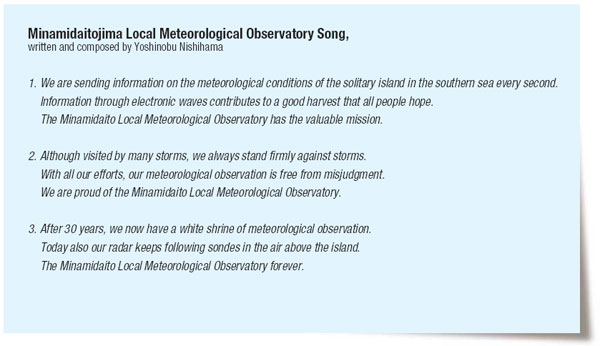Ocean Newsletter
No.74 September 5, 2003
-
Minami-daitojima, the Island on the Front of Typhoon Observation
Fumimasa Kinjo
Forecaster, Minami-daitojima Local Meteorological ObservatoryTyphoons cause great damage to Japan every year. The Minami-daitojima Local Meteorological Observatory, which is located on the Pacific south off the Japanese archipelago, carries out a crucial mission of monitoring the typhoons on the front in Japan. The Observatory observes and monitors meteorological phenomena, and issues the weather warnings, advisories and forecasts on a 24-hour basis. Minami-daitojima briefly famous nationwide, when typhoon occurs and approaches near Minami-daitojima. Most people, however, know little about the island's history, topography and natural environment. In this presentation I describe this tiny island. In detail, as it celebrates 103 years as reclamation. -
We Dropped Anchor, but the Ship didn't Stop!
Masaharu Hashimoto Nakamura Giken Kogyo Co., Ltd.
How do you stop a ship? Drop anchor. Most people believe it is as simple as that, but in fact the anchors used by Japanese ships and ships around the world suffer from numerous problems. For example, a dragging anchor can cause a shipwreck. Today it is well understood that a ship cannot always be stopped by dropping anchor, and few people are working on solutions. Research and development in reliable anchors is surely an important mission for Japan, a major shipbuilding country.
-
The Future of the Ocean Cruise
Ryushiro Urushima Representative Director, Ships Dreamy Co., Ltd.
Our ocean cruise company provides discounts for special occasions, such as a voyage with three generations traveling together, a honeymoon, or a golden wedding anniversary. Based in Hiroshima, we offer cruises through the Seto Inland Sea both east and west, and much more. It maybe said that the Japanese are the only target right now, however, one clear way forward is to develop a palette of new and appealing cruise ideas in Japan.
Minami-daitojima, the Island on the Front of Typhoon Observation
The Minamidaitojima Local Meteorological Observatory plays an important role as the first to monitor the conditions of typhoons, which cause great damage to various parts of Japan every year, and it carries out surface meteorological observation and forecasting/alerting services round-the-clock. It is ironical that Minamidaito Island gets nationwide publicity in the typhoon season, but its history, culture and natural environment are actually not well known. I would like to introduce the island, which marks the 103rd anniversary of its settlement.
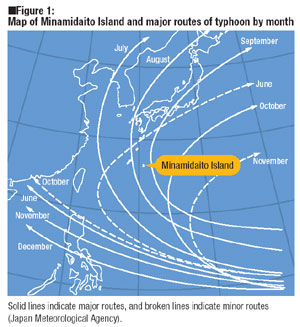 We often hear phrases such as, "Typhoon Long Wong (Dragon King) is currently over the sea to the southeast of Minamidaito Island ..." on TV and radio during their reports on typhoons.
We often hear phrases such as, "Typhoon Long Wong (Dragon King) is currently over the sea to the southeast of Minamidaito Island ..." on TV and radio during their reports on typhoons.
The Minamidaitojima Local Meteorological Observatory (Figure 1), where I work, is located in the Pacific Ocean about 360 kilometers to the east of the Okinawa Main Island, and more than 1,000 kilometers to the southwest of Tokyo. The observatory is an important observation point on the sea, where such points are few in number, and plays an important role as the first to monitor particularly the conditions of typhoons, which cause great damage to various parts of Japan every year. It is ironical that Minamidaito Island, which gets nationwide publicity in the typhoon season, can be referred to as "the very front line of the observation of typhoons," but its history, culture and natural environment are not so well known. I would like to briefly introduce the island, which marks its 103rd anniversary of settlement.
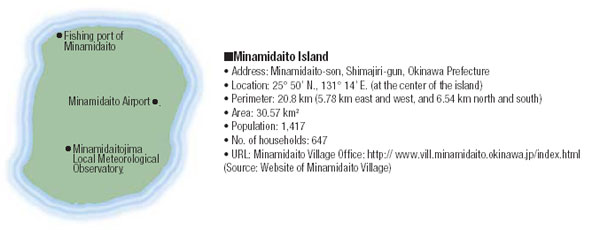
A Fusion of the Okinawan and Hachijojima Cultures
To begin with, the Daito Islands, which consist of Minamidaito Island, Kitadaito Island and Okidaito Island (Rasa Island), used to be uninhabited. The islands were called "Ufuagarijima (far east islands)" by the people in Ryukyu (another name for Okinawa). In 1885, the Okinawa prefectural government explored the islands and erected a national marker. Since then, the islands have belonged to Okinawa Prefecture. After that, several attempts were made to develop the islands. However, all attempts failed because the coasts of the Daito Islands are lined with precipitous rock walls of 10 to 20 meters, without shoals or coves, making it extremely difficult to disembark due to the high waves that roll in from the outer sea and beat the shore. Then, in 1900, a settlement team that was organized by Han-emon Tamaki, a wealthy merchant from Hachijo Island, that is located about 300 kilometers to the south of Tokyo and belongs to Tokyo, landed on Minamidaito Island, marking an important chapter in the history of settlement in Japan. After that, settlers were recruited from Hachijojima, and the island was developed as cane (a material for sugar) land, as it remains.
A large number of remote islands belong to Okinawa Prefecture and Tokyo. I had been working for the Hachijojima Weather Station in Tokyo until March 2003 before I was transferred to Minamidaito Island of Okinawa Prefecture in April. I felt nostalgic for Hachijo Island when I spotted some familiar family names in the telephone book, such as "Okuyama" and "Kikuchi," from Hachijojima, and also when I heard the sounds of Hachijojima drums and Okinawan folk songs at night from the Comprehensive Remote Islands Development Center, located next to the weather station. In addition, there are shrines, mikoshi (portable shrines), and edo sumo wrestling matches, which one rarely sees in Okinawa, so it could be said that the cultures of Okinawa and Hachijo Island have truly been fused on Minamidaito Island.
Passengers are also lifted in by crane.
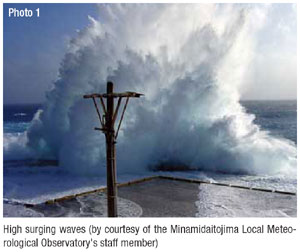
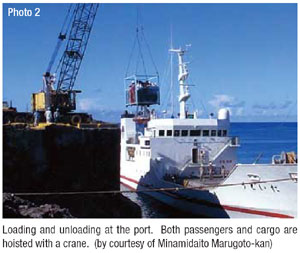
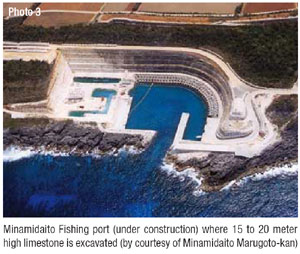
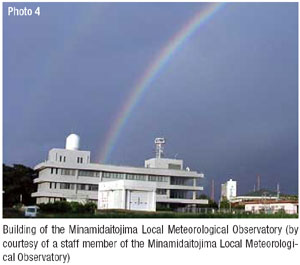
Minamidaito Island is a round uplifted coral island, and the highest elevation is only 75.8 m. A hilly terrain lies in the form of a ring around the perimeter of the island with a basin at the center. There are many freshwater ponds at the center, and their water levels are affected by sea tides like sea water levels. The island is in the oceanic subtropical zone, and also has meteorological characteristics unique to basin areas. The daily range of temperature is the greatest among the meteorological observatories under the jurisdiction of the Okinawa Meteorological Observatory and radiation fog also forms here.
Sugarcane is a key crop, with fields spreading all over the island, which is enclosed by windbreak forests around the perimeter. Each farm household has a relatively large field of more than 8.2 hectares, and large-scale management with the use of heavy machinery and assembly lines is established.
Even if a typhoon remains far from Minamidaito Island, swells make high waves. In such a case, ferries that carry daily commodities for islanders are cancelled. Because there is no pier where ships can touch down directly, commodities are hoisted from a ship by crane, as shown in Photo 2. Of course, passengers are also hoisted in order to get on shore. At present, a man-made fishing port is being built on the north side of the island by cutting deep into the limestone, with a section of the port opening provisionally in 2000. There is a splendid view of the manmade pier with its steep cliff of excavated limestone of about 20 meters in height (Photo 3).
Typhoons bring both blessings and curses.
During the Kan-non Festival, which is a traditional event held on July 17th, people pray for the sound health of livestock, prosperity, and also rain. The production of sugar in Minamidaito Island fluctuates from year to year, and the lowest annual production of sugar is sometimes shy of one half of the highest annual production, due to damage caused by typhoons or droughts. The people, therefore, are most earnest in carrying out the ritual rites.
As there was little rain for a while after the end of the rainy season in 2003, the Minamidaitojima Local Meteorological Observatory announced on July 15th that this would continue and raised a caution about dry conditions. Sugarcane fields visible from the observatory turned yellow. The phenomenon of sugarcane leaves rolling inward (in order to control the amount of evaporation) worsened, and sugarcanes withered. We then started receiving many phone calls from farmers. They complained and asked us, "Make it rain!" However even forecasters could not meet these requests.
Under these circumstances, we can only hope typhoons will bring good rain to the island. Typhoons cause great damage because of wild winds, but they also bring us blessed rain. Typhoons bring both blessings and curses to Minamidaito Island.
The observatory is charged with a mission to protect the island against disasters.
Meteorological observations in Minamidaito Island started in a meteorological station that was privately established by a sugar manufacturer in 1917. The meteorological station was placed under the authority of the then Central Meteorological Observatory (currently Japan Meteorological Agency) as an important national meteorological point in the Pacific Ocean, and started its service as the Minamidaito Meteorological Station of the Central Meteorological Observatory on February 1, 1942. The operation of the meteorological station was suspended temporarily due to World War II, but was restarted because of its importance as a meteorological observation point. After the era under the Ryukyu Government, Okinawa was returned to Japanese administration and the meteorological station has been serving as the Minamidaitojima Local Meteorological Observatory ever since(Photo 4).
The Minamidaitojima Local Meteorological Observatory carries out surface meteorological observation, aerological observation and forecasting/alerting services round-theclock as a governmental office for disaster prevention. In addition, in March 2003, the observatory started observation with the use of a wind profiler, which observes wind directions and velocity automatically in the air up to about five kilometers, and it is expected that typhoons and other meteorological phenomena will be analyzed three-dimensionally with the use of the wind profiler.
The Minamidaitojima Local Meteorological Observatory has its own song.
The Minamidaitojima Local Meteorological Observatory has its own song, something rare for national meteorological observatories. Yoshinobu Nishihama, a researcher who specialized in the history of the island, wrote and composed this song in 1962, and he contributed it to the observatory. The song has long been enjoyed by the staff of the observatory. Though observation equipment and forecasting technology have improved drastically through the years, we will keep working to reduce meteorological disasters in "the spirit of observation," which is woven into the song.
